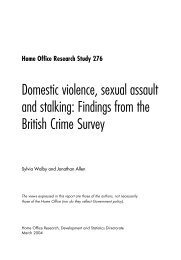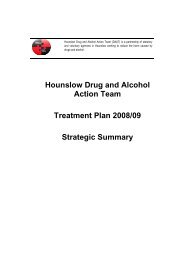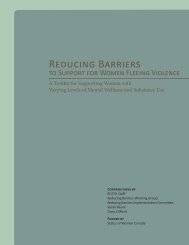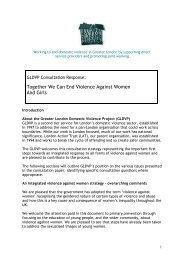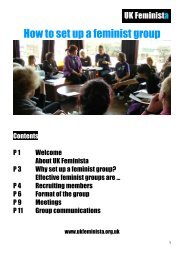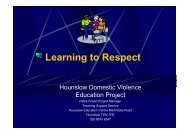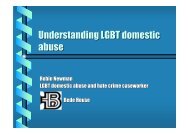1 Domestic violence information
Theory and Practice for the Substance Misuse Sector (pdf - AVA
Theory and Practice for the Substance Misuse Sector (pdf - AVA
You also want an ePaper? Increase the reach of your titles
YUMPU automatically turns print PDFs into web optimized ePapers that Google loves.
• A conservative estimate of the economic consequences of domestic<br />
<strong>violence</strong> found that it costs at least £900m per annum in London 6<br />
• <strong>Domestic</strong> <strong>violence</strong> accounts for 16% of homelessness acceptances 7<br />
• A study conducted into service provision for perpetrators of<br />
domestic <strong>violence</strong> found that male perpetrators were significantly<br />
more likely than female perpetrators to possess or use weapons.<br />
Police intelligence also showed that one in five (21%) of the<br />
perpetrators in the study were suspected of use of or dealing drugs 8<br />
• Research conducted with male respondents to the Scottish Crime<br />
Survey (2000) found that men were less likely to have been seriously<br />
injured, less likely to have been repeat victims of domestic assault,<br />
and less likely to report feeling fearful in their homes. When retraced,<br />
the majority of the male victims of domestic <strong>violence</strong> were also<br />
perpetrators of <strong>violence</strong> (13 of 22). A significant proportion of the<br />
men re-interviewed (13 of 46) later said they had actually never<br />
experienced any form of domestic abuse 9<br />
• A study of 200 women’s experiences of domestic <strong>violence</strong> found<br />
that 60% of the women had left because they feared that they or<br />
their children would be killed by the perpetrator 10<br />
• Among women surveyed in the British Crime Survey (2003),<br />
domestic <strong>violence</strong> is highest among those who are separated 11<br />
• Women are at greatest risk of being killed when separating from<br />
a violent partner. 12<br />
A review of domestic <strong>violence</strong> murders in<br />
London found that 76% occurred after the victim had ended<br />
the relationship 13<br />
1.3 <strong>Domestic</strong> <strong>violence</strong> ‘Power and Control Wheel’<br />
<strong>Domestic</strong> Abuse Intervention Project, Duluth, Minnesota<br />
The Power and Control Wheel was developed by women survivors<br />
of domestic <strong>violence</strong> in Duluth who had been abused by their male<br />
partners and were attending women’s education groups sponsored<br />
by the women’s refuge. This wheel illustrates some of the different<br />
abusive behaviours used by men toward women and may assist<br />
you in understanding the dynamics of domestic <strong>violence</strong>.<br />
PHYSICAL VIOLENCE SEXUAL<br />
USING COERCION<br />
AND THREATS<br />
• Making and/or carrying out<br />
threats to do something to hurt her<br />
• Threatening to leave her,<br />
to commit suicide,<br />
to report her to welfare<br />
• Making her<br />
drop charges<br />
USING ECONOMIC ABUSE<br />
• Preventing her from getting or<br />
keeping a job<br />
• Making her ask for money<br />
• Giving her an allowance<br />
• Taking her money<br />
• Not letting her know about or have<br />
access to family income<br />
USING MALE PRIVILEGE<br />
• Treating her like a servant<br />
• Making all the big decisions<br />
• Acting like the ‘master of the castle’<br />
• Being the one to define men’s<br />
and women’s roles<br />
• Making her do<br />
illegal things<br />
USING CHILDREN<br />
• Making her feel guilty<br />
about the children<br />
• Using the children<br />
to relay messages<br />
• Using visitation to harass her<br />
• Threatening to take<br />
the children away<br />
POWER<br />
AND<br />
CONTROL<br />
USING INTIMIDATION<br />
• Making her afraid by<br />
using looks, actions, gestures<br />
• Smashing things<br />
• Destroying her property<br />
• Abusing pets<br />
• Displaying weapons<br />
USING<br />
EMOTIONAL ABUSE<br />
• Putting her down<br />
• Making her feel bad about herself<br />
• Calling her names<br />
• Making her think she’s crazy<br />
• Playing mind games<br />
• Humiliating her<br />
• Making her feel guilty<br />
MINIMIZING, DENYING<br />
AND BLAMING<br />
• Making light of the abuse<br />
and not taking her concerns<br />
about it seriously<br />
• Saying the abuse didn’t happen<br />
• Shifting responsibility<br />
for abusive behaviour<br />
• Saying she caused it<br />
USING ISOLATION<br />
• Controlling what she does,<br />
who she sees and talks to,<br />
what she reads, where she goes<br />
• Limiting her outside involvement<br />
• Using jealousy to justify actions<br />
PHYSICAL VIOLENCE SEXUAL<br />
104<br />
© Stella Project Section 3 - <strong>Domestic</strong> Violence<br />
Copyright <strong>Domestic</strong> Abuse Intervention Project<br />
202 East Superior Street, Duluth, Minnesota 55802<br />
218-722-2781<br />
www.duluth-model.org<br />
© Stella Project Section 3 - <strong>Domestic</strong> Violence 105



